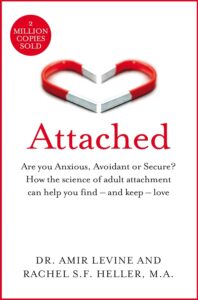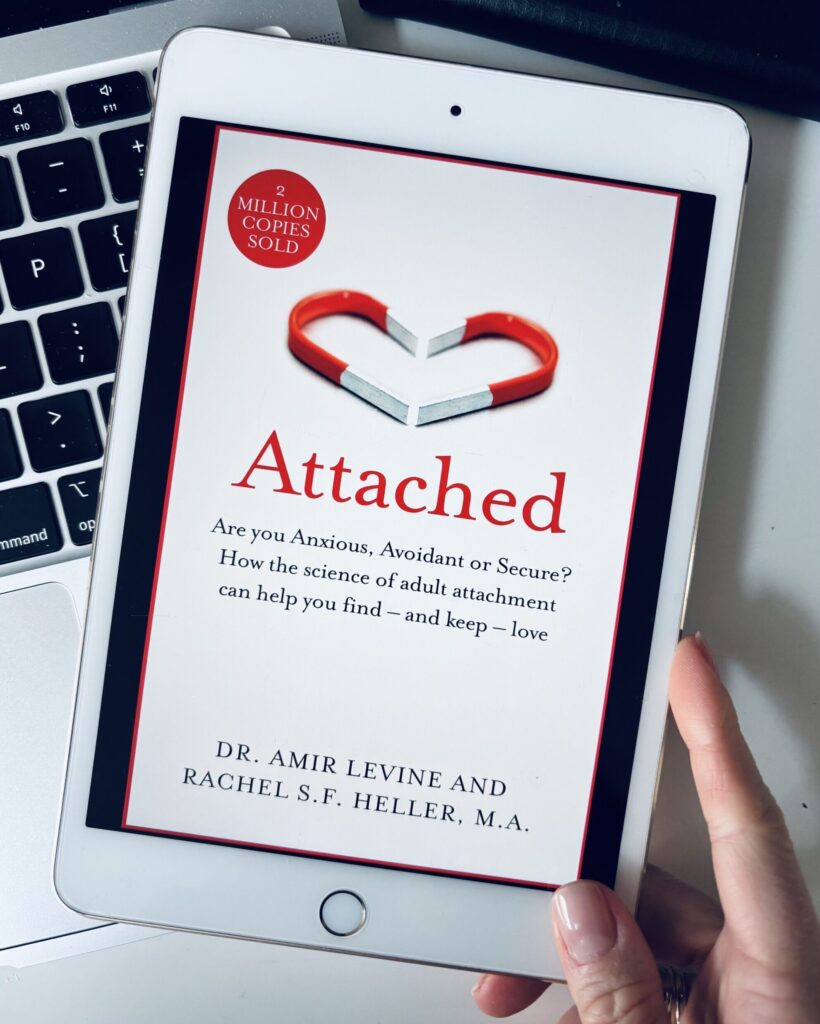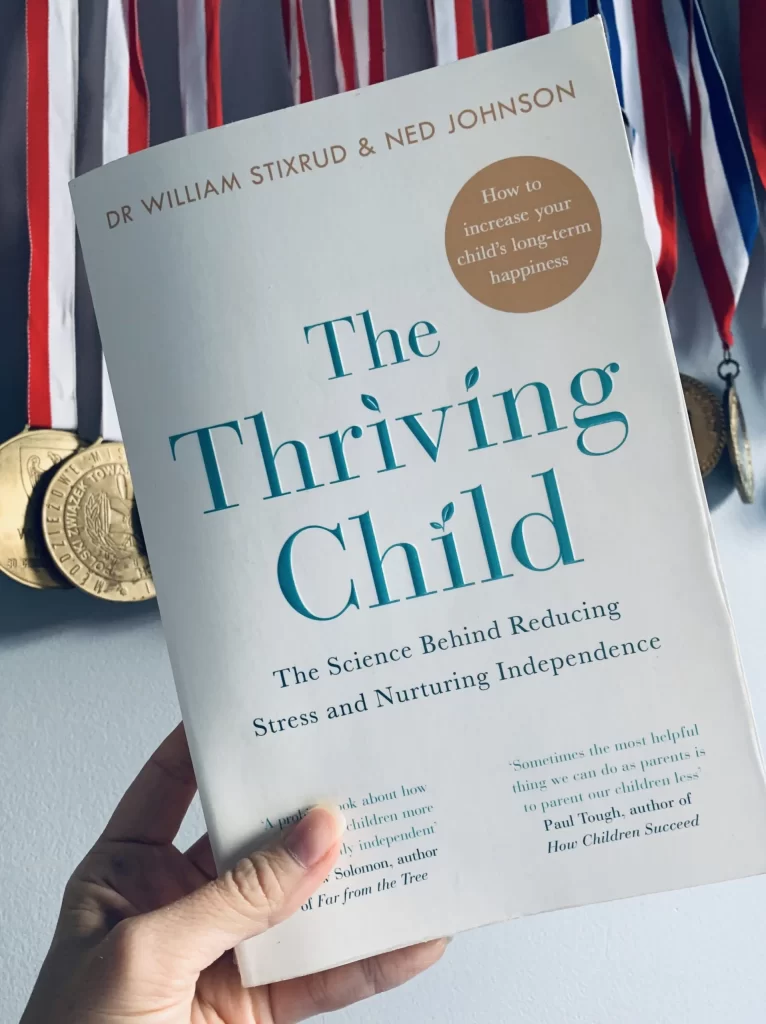 Attached
Attached
Are you Anxious, Avoidant or Secure? How the science of adult attachment can help you find – and keep – love
Amir Levine and Rachel Heller
Bluebird; Main Market edition (3 Jun. 2011)
About Amir Levine and Rachel Heller
Amir Levine, M.D., is an adult, child, and adolescent psychiatrist and neuroscientist. He graduated from the residency program at the New York Presbyterian Hospital/Columbia University, where he is currently a Principal Investigator on a research project sponsored by the National Institutes of Health. Dr. Levine has a private practice in New York City, where he lives with his family.
Rachel S.F. Heller, is a psychologist who works both in the public sector and in private practice. She holds a Master’s degree from Columbia University. In her work she integrates attachment-based principles with cognitive behavioral therapy and experiential-based approaches to help both children and adults.
About The Book
“By understanding that people vary greatly in their need for intimacy and closeness, and that these differences create clashes, adult attachment findings offered us a new way of looking at romantic relationships. But while the research made it easy to understand romantic liaisons better, how can we make a difference in them?
The theory held the promise of improving people’s intimate bonds, but its translation from the laboratory to an accessible guide – that people can apply to their own lives – didn’t exist. Believing that here lies a key to guiding people toward better relationships, we set out to learn as much as we could about the three attachment styles and the ways they interacted in everyday situations. […]
We discovered that unlike other relationship interventions that focus mostly either on singles or on existing couples, adult attachment is an overarching theory of romantic affiliation that allows for the development of useful applications for people in all stages of their romantic life. There are specific applications for people who are dating, those in early stages of relationships, and those who are in long-term ones, for people going through a breakup or those who are grieving the loss of a loved one. The common thread is that adult attachment can be put to powerful use in all of these situations and can help guide people throughout their lives to better relationships.”
Attachment theory is the backbone of almost every parenting book. Why? Because decades of research show that when kids have a secure attachment to their primary caregiver, they feel safe. Safe kids stress less, build confidence, and eventually become self-reliant. They learn to manage their emotions and behaviors, setting them up to thrive.
But what’s even more interesting is that studies also show that the way you were attached to your caregivers as a child shapes how you connect with people as an adult. Your attachment style influences your friendships, your romantic relationships, and even how you handle conflict. When I started looking for books on adult attachment, Attached by Amir Levine and Rachel Heller was everywhere. It’s one of the most recommended relationship books out there, so I had to check it out.
The book breaks down attachment science in a way that actually makes sense for even adults without kids. It builds on John Bowlby’s research, mixes in modern studies, and throws in real-life case studies. Levine and Heller explain the three main attachment styles, help you identify and understand your own, and show you how to recognize the styles of others—so you can choose the right partner or improve your current relationship.
If you’re dating, this book is a must read. It’ll help you avoid bad matches and make smarter choices. But it’s just as valuable for married couples and parents—because understanding attachment is a solid step towards better life.
It’s packed with insights, but here are a few of my favourite ideas that stuck with me.
Let’s dive in.
Key Insights
Three Attachment Styles: Secure, Anxious, and Avoidant
“Adult attachment designates three main “attachment styles,” or manners in which people perceive and respond to intimacy in romantic relationships, which parallel those found in children: Secure, Anxious, and Avoidant. Basically, secure people feel comfortable with intimacy and are usually warm and loving; anxious people crave intimacy, are often preoccupied with their relationships, and tend to worry about their partner’s ability to love them back; avoidant people equate intimacy with a loss of independence and constantly try to minimize closeness in addition, people with each of these attachment styles differ in:
– their view of intimacy and togetherness
– the way they deal with conflict
– their attitude toward sex
– their ability to communicate their wishes and needs
– their expectations from their partner and the relationship”
That’s a quick breakdown of attachment styles. Classic attachment theory actually includes a fourth style—disorganized attachment—which combines both anxious and avoidant traits, often rooted in trauma.
The book includes a simple quiz to help you figure out your attachment style (and spot other people’s), but if you want a shortcut, you can take it online on Attached book website.
So, what’s your attachment style? And what about your partner’s? Because once you know, relationships start making a whole lot more sense.
We Are Wired To Get Attached
“In fact, the need to be near someone special is so important that the brain has a biological mechanism specifically responsible for creating and regulating our connection with our attachment figures (parents, children, and romantic partners). This mechanism, called the attachment system, consists of emotions and behaviors that ensure that we remain safe and protected by staying close to our loved ones.”
Human connection isn’t just a nice-to-have—it’s a biological necessity. Our brains are wired with a built-in system designed to keep us close to the people we rely on most: parents, children, and romantic partners. This explains why babies scream when separated from their parents (cue – famous Strange Situation experiment). It’s not just a preference—it’s survival. In prehistoric times, being alone meant danger. Our brains evolved to treat separation as a life-or-death situation, triggering what’s known as protest behavior—crying, searching, panicking—until safety is restored. And here’s the kicker: we don’t outgrow this.
As adults, we transfer this attachment system to our romantic relationships. We might not throw tantrums like toddlers, but we still experience separation anxiety, emotional distress, and a deep need for reassurance when our partner pulls away. As Levine and Heller put it:
“Getting attached means that our brain becomes wired to seek the support of our partner by ensuring the partner’s psychological and physical proximity. If our partner fails to reassure us, we are programmed to continue our attempts to achieve closeness until the partner does.”
In other words, attachment isn’t just about love—it’s about security. Our brains are designed to seek closeness, and when that connection feels threatened, we react instinctively. This is why ghosting hurts so much, why fights over “needing space” escalate, and why even the most independent person still craves deep, reliable connection.
That brings us to the next idea.
Dependency Is Not a Bad Thing: Dependency Paradox
We like to think of ourselves as independent, self-sufficient beings. Social media glorifies the lone wolf—the boss, the hustler, the person who “needs no one.” But science says otherwise.
Once we form a deep attachment to someone, we literally become a physiological unit with them. Our partner affects our heart rate, blood pressure, breathing, and even hormone levels. As Levine and Heller put it:
“Numerous studies show that once we become attached to someone, the two of us form one physiological unit. Our partner regulates our blood pressure, our heart rate, our breathing, and the levels of hormones in our blood. We are no longer separate entities. The emphasis on differentiation that is held by most of today’s popular psychology approaches to adult relationships does not hold water from a biological perspective. Dependency is a fact; it is not a choice or a preference. […]
Translation? Independence is a myth. We’re wired for connection. The people closest to us don’t just support us emotionally; they literally regulate our nervous system. And here’s the paradox—the more securely attached we are to someone, the more independent we actually become.
Levine and Heller call this the dependency paradox:
“… the ability to step into the world on our own often stems from the knowledge that there is someone beside us whom we can count on.”
In other words, if you truly want to be confident, independent, and free, find the right person to depend on. The stronger your secure base, the more willing you are to take risks, explore new opportunities, and handle challenges.
And here’s where it gets really interesting for parents: Want your kids to grow into independent, resilient adults? Give them a secure base first (more on that later). When kids know they can always count on their parents, they feel safe enough to step out into the world.
So maybe the real flex isn’t being hyper-independent—it’s having someone who’s got your back, so you can take on life without fear.
Relationship Goal: Secure Attachment Style
Want to know the biggest predictor of happiness in a relationship? It’s not shared interests, great sex, or even good communication. It’s a secure attachment style.
Research is clear on this:
“Time and again, research shows that the best predictor of happiness in a relationship is a secure attachment style.
Studies demonstrate that individuals with a secure attachment style report higher levels of satisfaction in their relationships than people with other attachment styles.”
In other words, if you’re securely attached, your relationships are statistically more likely to be stable, fulfilling, and drama-free.
And this is exactly why being a reliable attachment figure for your kids matters so much. Secure kids grow into secure adults, and secure adults have healthier, happier relationships.
But what if you’re not securely attached? What if you lean anxious or avoidant? Does that mean you’re doomed to endless relationship struggles? Nope. You still have a huge advantage—you just need to be intentional. The best move? Find a securely attached partner. Secure people create stability in relationships, and over time, that stability can help you rewire your attachment patterns.
The book dives deep into dating strategies for each attachment style, so if you’re looking for solid guidance, it’s worth checking out.
But for now, let’s focus on something even more powerful: No matter what your attachment style is, you can consciously change your behaviour to provide a secure base for your partner.
Here’s how.
Provide a Secure Base
“… one of the most important roles we play in our partners’ lives is providing a secure base: creating the conditions that enable our partners to pursue their interests and explore the world in confidence.”
We all wish our partners would magically become more secure, confident, and emotionally available. But here’s the reality: you can’t change other people. What you can do is change your own behaviour—and in relationships, that’s a game-changer. When you start acting more secure, your partner often follows suit (and if they don’t? Well, that’s a red flag).
Levine and Heller highlight that in a 2010 study, Brooke Feeney and Roxanne Thrush from Carnegie Mellon University found that secure relationships are built on three key behaviours:
“- Be available: Respond sensitively to their distress, allow them to be dependent on you when they feel the need, check in with them from time to time, and provide comfort when things go wrong.
– Don’t interfere: Provide behind-the-scenes support for their endeavors. Help in a way that leaves them with the initiative and the feeling of power. Allow them to do their own thing without trying to take over the situation, micromanage, or undermine their confidence and abilities.
– Encourage: Provide encouragement and be accepting of their learning and personal growth goals. Boost their self-esteem.”
This takes effort. Acting secure—especially if you’re naturally anxious or avoidant—means rewiring old patterns. But this kind of personal growth is worth it because it leads to deeper, stronger relationships.
And here’s another key to creating a secure relationship: effective communication. There’s a whole chapter in the book on communication skills, and a lot of it overlaps with Nonviolent Communication (NVC)—a framework developed by Marshall Rosenberg (if you haven’t read Nonviolent Communication, do yourself a favour and check out our notes).
Spoiler: The biggest skill you need? Learning how to express your needs and feelings clearly, without blame or criticism.
And if you’re a parent looking to raise securely attached kids, this concept applies to you, too. I highly recommend checking out The Power of Showing Up by Dan Siegel and Tina Payne Bryson—it’s packed with practical tools for fostering secure attachment in childhood.
Secure Priming
“Attachment research shows that people tend to become more secure when they are in a relationship with someone secure.
But there is also hope for a couple’s future when neither partner is secure. Studies have found that security “priming” — reminding people of security-enhancing experiences they’ve had – can help them to create a greater sense of security. When people can recall a past relationship with a secure person or be inspired by a secure role model in their lives, they are often successful at adopting secure ways. As a person’s attachment style gradually changes toward greater security, he or she behaves more constructively in relationships and even enjoys better mental and physical health. And if both partners are able to do so—the results can be remarkable.
Our memories are not like old books in the library, lying there dusty and unchanged; they are rather like a living, breathing entity. What we remember today of our past is in fact a product of editing and reshaping that occurs over the years whenever we recall that particular memory. In other words, our current experiences shape our view of our past ones. By creating your own attachment inventory, you reexamine your recollections of past relationship experiences from a fresh new perspective.
Viewing them through an attachment lens will allow you to change some unhelpful beliefs that rely on those particular memories, and by so doing reshape your working model into a more secure one.”
If you’re stuck in an insecure attachment loop, here’s some good news: you can rewire your attachment style—and you don’t even need a therapist to do it.
Turns out, security can be “primed.” Think of it like a mental shortcut. If you consciously recall times when you felt safe and supported in a relationship—whether with a past partner, a parent, a friend, or even a mentor—you start reinforcing the belief that secure attachment is possible for you. And once that belief takes root, you naturally start behaving in more secure ways.
If in The Power of Showing Up Dan Siegel and Tina Payne Bryson recommend making sense of your childhood as the first step to breaking the cycle of insecure attachment, Levine and Heller take a more cognitive-behavioural approach: challenge your attachment beliefs by consciously recalling times when you felt secure.
This could be a game-changer for parents working through their own attachment struggles. If you’re trying to raise securely attached kids but wrestling with your own insecurities, this is another tool in your toolbox. You can break the generational cycle by first proving to yourself that secure relationships are possible—even if you didn’t always have them growing up.
Relationship Wisdom in 4 Facts
“- Your attachment needs are legitimate.
– You shouldn’t feel bad for depending on the person you are closest to—it is part of your genetic makeup.
– A relationship, from an attachment perspective, should make you feel more self-confident and give you peace of mind. If it doesn’t, this is a wake-up call!
– And above all, remain true to your authentic self-playing games will only distance you from your ultimate goal of finding true happiness, be it with your current partner or with someone else.”
That’s the epilogue in a nutshell, and honestly, those last two points might be some of the best dating advice out there.
If you want to dive deeper into relationships and marriage, check out our article: 6 Relationship Books Every Couple Should Read.
Action Steps For You:
- Identify Your Attachment Style (and Your Partner’s): Take the quiz in the book (or online here) to determine whether you’re secure, anxious, or avoidant. Then, observe your partner’s behaviour to identify their style. Awareness is the first step to making intentional changes.
- Communicate Your Needs Clearly: If you’re anxious, you might hesitate to express your needs for fear of being “too much.” If you’re avoidant, you might downplay your emotions to maintain independence. Attached makes it clear: healthy relationships thrive on direct communication. Instead of playing games, say what you need in a calm, confident, and non-blaming way. Example: Instead of saying, “You never text me back. Do you even care?” Try: “I feel more connected when we check in during the day. Can we make that a habit?”
- If You’re Anxious or Avoidant, Choose a Secure Partner: One of the biggest hacks for improving your love life? Date someone secure. If you’re anxious or avoidant, being with a secure person can help you develop a healthier attachment style over time. Bonus: If you’re already in a relationship, you can work on becoming more secure yourself by practicing secure behaviours—being available, encouraging, and communicating openly.
Quotes From The Book
“In a true partnership, both partners view it as their responsibility to ensure the other’s emotional well-being.”
“True love, in the evolutionary sense, means peace of mind. “Still waters run deep” is a good way of characterizing it.”
“If you’re secure, one of the reasons you’re able to maintain a satisfying relationship with someone who has an insecure attachment style is because he or she will gradually become more secure as a result of being with you.”
“Research on attachment repeatedly shows that when your need for intimacy is met and reciprocated by your partner, your satisfaction level will rise. Incongruent intimacy needs, on the other hand, usually translate into substantially lower satisfaction. When couples disagree about the degree of closeness and intimacy desired in a relationship, the issue eventually threatens to dominate all of their dialogue. We call this situation the “anxious-avoidant trap,” because like a trap, you fall into it with no awareness, and like a trap, once you’re caught, it’s hard to break free.”
“The ability to recall your own childhood memories of your relationships with your primary caregivers in a more coherent manner has remarkable effects; it helps you become a better, more reflective parent and improves other areas of your life.”
“Attachment principles teach us that most people are only as needy as their unmet needs. When their emotional needs are met, and the earlier the better, they usually turn their attention outward. This is sometimes referred to in attachment literature as the “dependency paradox”: The more effectively dependent people are on one another, the more independent and daring they become.”



